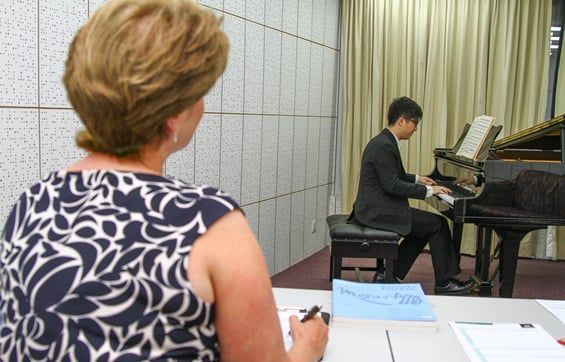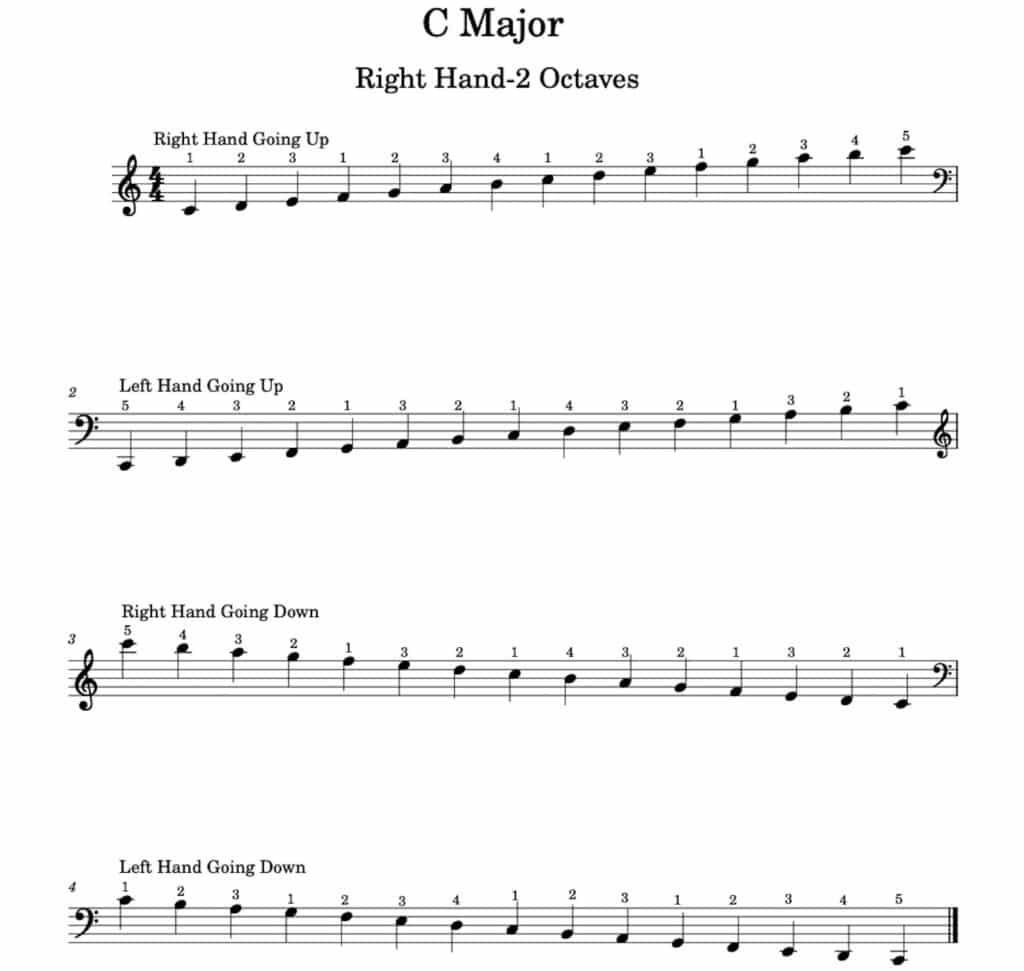Practical Exams – 2 weeks to go!

The Spring Term ABRSM practical exam session will soon be underway and some of our Tip Top musicians have exams in early March.
I’ve been thinking of how young musicians should use this last couple of weeks to prepare. At this point, all the scales and arpeggios should be very confident and the three pieces should be secure and musical. However, there is a tendency for musicians to coast in the last couple of weeks and rather than making further improvements, it is easy to just play through everything with no thought of how the performance could be improved. From now on, your exam needs to be a priority when planning your week so organising sleep overs, holidays and scout camps right near an exam can mean students miss days of practise and they are even too tired on the day of the exam. I’ve known students turn up to a concert or exam and they’ve been on a sleep over the night before and not even played the piano for two days – they don’t feel particularly confident! It does not go well….
Here are some tips for parents and students.
1) Scales and Arpeggios are the first thing to be played in a piano exam and if they are strong and assured, it sets an excellent first impression to the examiner. It is absolutely possible to get 21/21 for these which need to be played from memory. They should be firm, nicely shaped and played at a tempo appropriate to the grade. Work on scales and arpeggios first and play ALL of them every day and check you are playing with a good posture and hand shape (no flat fingers). It should not be an onerous task to play them all every day.
**If a scale or arpeggio is not perfect first time, work on this by checking the correct notes and fingerings, doing separate hands practise or sometimes play one octave. Always play at a speed where there are NO mistakes and aim to get the scale correct three times in a row. Play the scales and arpeggios in a random order, parents could ask them or write each scale and arpeggio on a piece of paper and draw them out of a hat.**

Flautists should also work on one octave if there is errors and when securing the notes, don’t worry about taking extra breaths because you want ACCURACY before fluency. Again, aim for correct playing of a scale/arpeggio THREE times in a row. Can you play just as well slurred as tongued?
I often say to students ‘Aim for the hat trick’ That means playing something correct, correct, correct NOT wrong, wrong, correct, wrong, wrong, correct, wrong, correct because this still means you have played it incorrectly more often than accurately – it will not be secure, this type of practising is ‘gambling’. Too risky.
2) Pieces are worth 90 marks (30 marks per piece) – There are three contrasting pieces to prepare for the exam. At this point, ensure that you are practising in two ways. It is good to ‘play through’ without stopping because this is what you will have to do in your exam. Also play through to family and friends, it is helpful to have a parent video your pieces so you can listen back and see if you have a good posture/hand position (breath control on flute). The examiner will also be typing in the exam so it is good for young musicians to play with some distractions around every so often aswell!
Are you playing expressively? Perhaps your piece has a title that helps you to think of a story or picture that helps to makes your playing interesting and colourful. Practise PERFORMING just as you would for a concert. Is your posture and hand position good? Do you count yourself in your head before you play? Do you END the piece well? Some children play the last note and begin to look around or even stand up before they have finished, make sure you start well and finish well – don’t throw away the ending!
However, it is also important to continue to do SLOW, SEPARATE, SECTION practise where you pay attention to improving any weak sections – I often write on your music which bars or sections need extra work. Check that you have taken on board all the details in your pieces. Pay attention to dynamics, articulation, tempo changes, pauses, ornaments expression marks and any other features of your pieces. I often ask students to identify the loudest part of the piece and the quietest to help shade the dynamics. Check you a playing at a suitable tempo, pop the metronome on. Be careful not to just race through each piece with no consideration for musicality.
It is helpful to listen to recordings of the pieces to inspire the student and also clarify what the piece should sound like. It is particularly important for flaustists to be familiar with the piano accompaniment so do listen to recordings and play with your accompanist regularly.
If possible, play some or all of your exam piece in a concert to give you valuable experience.
3) Sight Reading is worth 21 marks and this can be sadly neglected and where this is a weakness, the marks lost can mean that merits and distinctions are just missed out by a couple of marks. Sight reading should be worked on EVERY DAY. I set rhythmic and melodic sight reading work every lesson. In the exam, candidates are given only THIRTY seconds to look at the sight reading test and try it through. Musicians need to hone their sight-reading skills DAILY so that the exam test is manageable. I give a lot of advice to students according to their level so please look at what I write in books. In the exam, the examiner doesn’t expect absolute perfection but you do need to keep going.
Please remember to:
· Check the key signature and look for accidentals
· Check the time signature, count yourself in a keep counting
· Plan your fingerings and look what the highest and lowest notes are, early grades should be looking for steps/skips
· Grade 3 piano onwards will include changes of hand position, notice the fingerings.
· When you have 30 seconds to try the piece you cannot just play the first bar 6 times, you need to get an idea of the notes and fingerings.
· When attempting the test go steady, count yourself in, look ahead of what you are playing (long notes are a gift! They give you time to think and look ahead!) and KEEP GOING. DO NOT STOP. DO NOT GO BACK TO CORRECT NOTES.
Another very important developmental aspect of sight reading is playing LOTS of different music. If students only play the same three exam pieces for months on end, their reading will be very weak. So I regularly set easier pieces that should be learned in a week, to ensure young musicians are regularly reading new notes. Duet and ensemble playing is also very helpful in improving sight reading as when you play with other musicians, you HAVE to keep going. This term, everyone should be learning at least one new Christmas piece each week. These pieces should be easier than the grade pieces but stretch you a bit more than the sight reading examples.
If musicians do not work on the skills of sight reading, they will at some point hit a standstill where they might be able to learn a grade 5 piece, basically by rote, but their reading is so poor, they can’t quickly learn a grade 2 piece.
Being good at sight reading is such a blessing, it means that you can decipher and learn music quickly, wonderful! Developing sight reading skills is a crucial part of being a rounded musician and you will be able to make music with other musicians and enjoy it.
4) The Aural Tests are worth 18 marks and like sight reading, some students neglect this and aural test marks will be low and could mean you don’t get the merit or distinction that you would like.
The best way to develop good aural skills is to sing in the school or church choir so that you are familiar with your voice and your vocal range. I cover the tests in your lesson and try to help you but I can only do this for a brief time in the lesson so students need to spend time in the week working on aural skills. If you practise the tests by using the YouTube links I send or ‘Improve Your Aural Skills’ books and CDs you will not be flummoxed in the exam and you won’t be disappointed with your overall result. There is also an ABRSM Aural test app for iphones which has helped students greatly.
Please see https://www.tiptoptutoring.co.uk/aural-test-training for lots of links to help you work on clapping the beat, singing, spotting the differences, describing music and more.
The Aural Tests are designed to help you develop your overall musicianship. This can be very helpful in preparing for GCSE and A level exams as well as auditions.
You might manage the early grades with poor aural skills but if you do not continue to develop your aural skills, you will hit a road block once the tests get longer and more involved at grades 4 and 5 onwards. Listen to classical music and go to concerts whenever possible, the more children listen to quality music the better.
Good luck everyone and continue to look where you can improve your playing before the exam.



